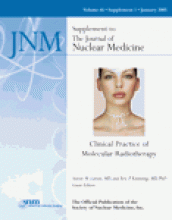Abstract
The kidneys are critical organs in peptide receptor radiation therapy (PRRT). Renal function loss may become apparent many years after PRRT. We analyzed the time course of decline in creatinine clearance (CLR) in patients during a follow-up of at least 18 mo after the start of PRRT with 90Y-1,4,7,10-tetraazacyclododecane-N,N′,N″,N‴-tetraacetic acid (DOTA),Tyr3-octreotide (90Y-DOTATOC) or 177Lu-DOTA0,Tyr3-octreotate (177Lu-DOTATATE). Methods: Twenty-eight patients with metastasized neuroendocrine tumors received 1–5 cycles of 90Y-DOTATOC, leading to renal radiation doses of 5.9–26.9 Gy per cycle and a total of 18.3–38.7 Gy. Median follow-up was 2.9 y (range, 1.5–5.4 y), with a median of 16 measurements (range, 5–53) per patient. Thirty-seven patients with metastasized neuroendocrine tumors received 3–7 cycles of 177Lu-DOTATATE, leading to renal radiation doses of 1.8–7.8 Gy per cycle and a total of 7.3–26.7 Gy. Median follow-up was 2.4 y (range, 1.7–4.0 y), with a median of 10 (range, 6–27) measurements per patient. All renal dose estimates were calculated with the MIRDOSE3 model. All patients were infused with renoprotective amino acids during the administration of the radioactive peptides. The time trend of CLR was determined by fitting a monoexponential function through the data of individual patients, yielding the decline in CLR in terms of percentage change per year. Results: The median decline in CLR was 7.3% per y in patients treated with 90Y-DOTATOC and 3.8% per y in patients treated with 177Lu-DOTATATE (P = 0.06). The time trend of decline in CLR was sustained during the follow-up period. Eleven patients had a >15% per y decline in CLR. Cumulative renal radiation dose, per-cycle renal radiation dose, age, hypertension, and diabetes are probable contributing factors to the rate of decline in CLR after PRRT. Conclusion: This study showed that the time course of CLR after PRRT was compatible with the pattern of sustained CLR loss in progressive chronic kidney disease.
- 90Y-DOTA0,Tyr3-octreotide
- 177Lu-DOTA0,Tyr3-octreotate
- peptide receptor radiation therapy
- radiation nephropathy
- chronic kidney disease
Footnotes
Received Jun. 17, 2004; revision accepted Sep. 30, 2004.
For correspondence or reprints contact: Roelf Valkema, MD, Department of Nuclear Medicine, Erasmus Medical Center, Dr Molewaterplein 40, Rotterdam, The Netherlands 3015 GD.
E-mail: r.valkema{at}erasmusmc.nl







